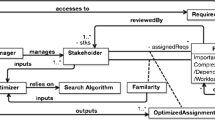Abstract
Technological innovations and changing customer trends brought by globalization has led tough competition among various industries throughout the globe. Their assiduous efforts to develop new product is crucial for survival. To overcome this problem and to develop a quality product that generates revenue, a dynamical multi-objective evolutionary algorithm(DMOEA) incorporated with quality function deployment (QFD) and fuzzy analytic network process (FANP) is proposed. The proposed approach considers goals such as new product development (NPD) time and cost, technological advancement, and manufacturability for selection of the most suitable product technical requirements (PTRs). A case study of software development is included to demonstrate the effectiveness of the proposed approach and the obtained results are discussed.
Access this chapter
Tax calculation will be finalised at checkout
Purchases are for personal use only
Similar content being viewed by others
References
Akao Y (1990) Quality function deployment: integrating customer requirements into product design. Productivity Press, Cambridge
Armacost RL, Componation PJ, Mullens MA, Swart WW (1994) An AHP framework for prioritizing customer requirements in QFD: an industrialized housing application. IIE Trans 26(4):72–79
Buyukozkan G, Kahraman C, Ruan D (2004) A fuzzy multi-criteria decision approaches for software development strategy selection. Int J Gen Syst 33(2–3):259–280
Chan LK, Kao HP, Ng A, Wu ML (1999) Rating the importance of customer needs in quality function deployment by fuzzy and entropy methods. Int J Prod Res 37(11):2499–2518
Chen Y, Tang J, Fung RYK, Ren Z (2004) Fuzzy regression-based mathematical programming model for quality function deployment. Int J Prod Res 42(5):1009–1027
Deb K, Pratap A, Agarwal S, Meyarivan T (2002) A fast and elitist multi-objective genetic algorithm: NSGA-II. IEEE Trans Evol Comput 6(2):182–197
Eiben AE, Raue PE, Ruttkay ZS (1994) Genetic algorithms with multi-parent recombination. Proceeding of the 3rd conference on parallel problem solving from nature, LNCS 866, Springer-Verlag, pp 78–87
Einhorn HJ, Hogarth RM (1986) Decision making under ambiguity. J Bus 59:225–250
Ertay T, Buyukozkan G, Kahraman C, Ruan D (2005) Quality function deployment implementation based on analytic network process with linguistic data: an application in automotive industry. J Intell Fuzzy Syst 16(1):221–232
Fleming P, Purshouse RC, Lygoe RJ (2005) Many objective optimization: an engineering design perspective. In: Evolutionary multi-criterion optimization, LNCS, vol 3410, pp 14–32
Fleming P, Purshouse RC (2007) On the evolutionary optimization of many conflicting objectives. IEEE Trans Evol Comput 11(7):770–784
Fonseca CM, Fleming P (1993) Genetic algorithms for multi-objective optimization: Formulation, discussion and generalization: In: Forrest S (ed) Proceedings of the fifth international conference on genetic algorithms. Morgan Kauffman, San Mateo, pp 416–423
Fukuda S, Matsuura Y (1993) Prioritizing the customer’s requirements by AHP for concurrent design. ASME Des Eng Div 52:13–19
Griffin A, Hauser JR (1993) The voice of customer. J Mark Sci 12(1):1–27
Hauser JR, Clausing D (1988) The house of quality. Harvard Bus Rev 66:63–73
Ho ES, Lai YJ, Chang SI (1999) An integrated group decision-making approach to quality function deployment. IIE Trans 31(6):553–567
Kahraman C, Ertay T, Buyukozkan G (2006) A fuzzy optimisation model for QFD planning process using analytic network approach. Eur J Oper Res 171(2):390–411
Karsak EE, Sozer S, Alptekin SE (2002) Product planning in quality function deployment using a combined analytic network process and goal programming approach. Comput Ind Eng 44(1):171–190
Kim KJ, Moskowitz H, Dhingra A, Evans G (2000) Fuzzy multi-criteria models for quality function deployment. Eur J Oper Res 121(3):504–518
Klir GJ, Yuan B (1995) Fuzzy sets and fuzzy logic theory and applications. Prentice-Hall International, London
Knowles J, Corne D (1999) The Pareto archived evolution strategy: a new baseline algorithm for Pareto multi-objective optimization. Proceeding of the 1999 congress on evolutionary computation, Washington, DC, USA
Koppen M, Yoshida K (2007) Substitute distance assignments in NSGA-II for handling multi-objective optimization problems. In Proceedings of 4th international conference evolution multi-criteria optimization, vol 4403. Springer-Verlag, New York, pp 727–741
Kwong CK, Bai H (2002) A fuzzy AHP approach to the determination of importance weights of customer requirements in quality function deployment. J Intell Manuf 13:367–377
Lee AHI, Chen HH, Tong Y (2008) Developing new products in a network with efficiency and innovation. Int J Prod Res 48(17):4687–4707
Lee AHI, Kang HY, Yang CY, Lin CY (2009) An evaluation framework for product planning using FANP, QFD and multi-choice goal programming. Int J Prod Res 48(13):3977–3997
Lu M, Madu CN, Kuei C, Winokur D (1994) Integrating QFD, AHP, and benchmarking in strategic marketing. J Busi Indust Market 9(1):41–50
Park T, Kim K (1998) Determination of an optimal set of design requirements using house of quality. J Oper Manage 16(5):569–581
Saaty TL (1980) The analytic hierarchy process. McGraw-Hill, New York
Saaty TL (1996) Decision making with dependence and feedback: the analytic network process. RWS Publications, Pittsburgh
Shen XX, Tan KC, Xie M (2001) The implementation of quality function deployment based on linguistic data. J Intell Manuf 12(1):65–75
Shillito ML (1994) Advanced QFD: linking technology to market and company needs. Wiley, New York
Sakawa M, Yano H, Yumine T (1987) An interactive fuzzy satisfying method for multi-objective linear programming problems and its application. IEEE Trans Syst Man Cyber-Part A: Syst Hum 17(4):654–661
Yager RR (1978) On a general class of fuzzy connective. Fuzzy Sets Syst 4(3):235–242
Zitzler E, Laumanns M, Thiele L (2001) SPEA2: improving the strength Pareto evolutionary algorithm. Technical report, TIK-report 103, Swiss Federal Institute of Technology, Lausanne, Switzerland
Zou X, Chen Y, Liu M, Kang L (2008) A new evolutionary algorithm for solving many-objective optimization problems. IEEE Trans Syst Man Cyber-Part B 38(5):1402–1412
Author information
Authors and Affiliations
Corresponding author
Editor information
Editors and Affiliations
Rights and permissions
Copyright information
© 2014 Springer-Verlag London
About this chapter
Cite this chapter
Mungle, S., Saurav, S., Tiwari, M.K. (2014). Multi-objective Optimization Approach to Product-planning in Quality Function Deployment Incorporated with Fuzzy-ANP. In: Benyoucef, L., Hennet, JC., Tiwari, M. (eds) Applications of Multi-Criteria and Game Theory Approaches. Springer Series in Advanced Manufacturing. Springer, London. https://doi.org/10.1007/978-1-4471-5295-8_4
Download citation
DOI: https://doi.org/10.1007/978-1-4471-5295-8_4
Published:
Publisher Name: Springer, London
Print ISBN: 978-1-4471-5294-1
Online ISBN: 978-1-4471-5295-8
eBook Packages: EngineeringEngineering (R0)




